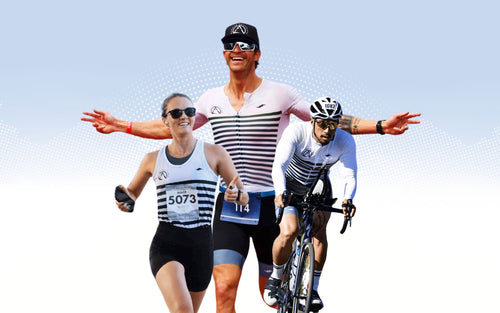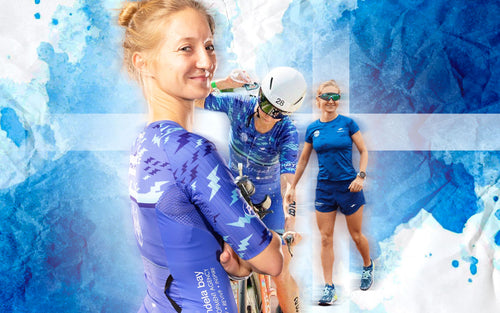What Is A Duathlon, And Who Should Join One?

A duathlon is sometimes dubbed ‘the triathlon for non-swimmers’ because of its format of combining running and cycling, but that label is a bit misleading. As we will see in this article duathlon are for everyone, even those of us who can swim.
A duathlon is an event in which competitors complete a run, followed by a cycle, followed by a final run. There are 4 official distances, ranging from sprint (5km run, 20km bike, 2.5km run) through to the long distance (10km run, 150 km bike, 30km run). However, there is a lot of flexibility in distances, with event organisers working with whatever the terrain allows.
Format Of A Duathlon
The format of a duathlon is not a simple case of run and then bike. Events will start with one run, followed by the bike leg, and then finish up with a second run. Because of this you need to have been doing a lot of brick workouts, going from running to the bike and back again. You are using different muscle groups for running and cycling so you will want to get your body used to the change from one discipline to the other.
Distances Of A Duathlon
While distances can vary wildly based on the location and the organiser, there are four generally recognized distances.
Sprint Distance – 5km run | 20km bike | 2.5km run
Standard Distance – 10km run | 40km bike | 5km run
Middle Distance – 10km run | 60km bike | 10km run
Long Distance – 10km run | 150km bike | 30km run
A quick search for duathlons in your local area will likely show a lot of variation. In the US it is not uncommon to see the run distances of a standard duathlon flipped, so that you start with the shorter run and end with the long one. You may also find events in which both the run legs are the same distance. You can check out www.trifind.com and see what events are coming up in your area.
Who Should Join A Duathlon?
Non-Swimmers – We’ll deal with the obvious one first. The swim leg of a triathlon can be the thing that puts off many would-be triathletes. There is no hiding if you are a weak swimmer, and the fear of the open ocean (thalassophobia) is a real thing. If you have ever sat there and said ‘I’d love to do a triathlon, but I can’t swim’, then now you have no excuses.
Triathletes – Oftentimes triathlons can be turned into duathlons on the day, if ocean conditions are considered dangerous. It is a great idea to have a few duathlons under your belt so you know how they feel and you are not thrown if the swim leg is dropped from your event.
Mountain Bikers – The image of the cyclist for triathlons is usually one of light Lycra and aero bikes but there are quite a few duathlons that are raced over extreme conditions. If you are more into muddy paths than smooth asphalt, then these events could be the excitement you are looking for. Xterra have quite a few events across the US that you can check out.
Newbies – If you are new to multisport events then duathlons are a great way to get your toes wet (or not wet in this case!). Go along and soak up the atmosphere and this might be the first step of your multisport adventure.
Final Thoughts
Triathlons, cycling events and running events have the tendency at times to be quite serious, and this can be off-putting for those who are new to those sports. Even seasoned triathletes can suffer from the feeling of ‘should I really be here?’ when turning up to a run or a bike race. Duathlons do not seem to suffer from the same issue; they are fun!
Whether it is because they are ‘not really triathlons’, or because they are for ‘people who can’t swim’, there is something more light-hearted about duathlons. They are often held at events where triathlons are being run at the same time and so they are not seen as the blue-ribbon event and this helps keep them more relaxed. If you are not convinced then sign up for one and find out for yourself; what do you have to lose?
Written for Innerforce by Stewart Spiessens
Photos. @philkassel

A duathlon is sometimes dubbed ‘the triathlon for non-swimmers’ because of its format of combining running and cycling, but that label is a bit misleading. As we will see in this article duathlon are for everyone, even those of us who can swim.
A duathlon is an event in which competitors complete a run, followed by a cycle, followed by a final run. There are 4 official distances, ranging from sprint (5km run, 20km bike, 2.5km run) through to the long distance (10km run, 150 km bike, 30km run). However, there is a lot of flexibility in distances, with event organisers working with whatever the terrain allows.
Format Of A Duathlon
The format of a duathlon is not a simple case of run and then bike. Events will start with one run, followed by the bike leg, and then finish up with a second run. Because of this you need to have been doing a lot of brick workouts, going from running to the bike and back again. You are using different muscle groups for running and cycling so you will want to get your body used to the change from one discipline to the other.
Distances Of A Duathlon
While distances can vary wildly based on the location and the organiser, there are four generally recognized distances.
Sprint Distance – 5km run | 20km bike | 2.5km run
Standard Distance – 10km run | 40km bike | 5km run
Middle Distance – 10km run | 60km bike | 10km run
Long Distance – 10km run | 150km bike | 30km run
A quick search for duathlons in your local area will likely show a lot of variation. In the US it is not uncommon to see the run distances of a standard duathlon flipped, so that you start with the shorter run and end with the long one. You may also find events in which both the run legs are the same distance. You can check out www.trifind.com and see what events are coming up in your area.
Who Should Join A Duathlon?
Non-Swimmers – We’ll deal with the obvious one first. The swim leg of a triathlon can be the thing that puts off many would-be triathletes. There is no hiding if you are a weak swimmer, and the fear of the open ocean (thalassophobia) is a real thing. If you have ever sat there and said ‘I’d love to do a triathlon, but I can’t swim’, then now you have no excuses.
Triathletes – Oftentimes triathlons can be turned into duathlons on the day, if ocean conditions are considered dangerous. It is a great idea to have a few duathlons under your belt so you know how they feel and you are not thrown if the swim leg is dropped from your event.
Mountain Bikers – The image of the cyclist for triathlons is usually one of light Lycra and aero bikes but there are quite a few duathlons that are raced over extreme conditions. If you are more into muddy paths than smooth asphalt, then these events could be the excitement you are looking for. Xterra have quite a few events across the US that you can check out.
Newbies – If you are new to multisport events then duathlons are a great way to get your toes wet (or not wet in this case!). Go along and soak up the atmosphere and this might be the first step of your multisport adventure.
Final Thoughts
Triathlons, cycling events and running events have the tendency at times to be quite serious, and this can be off-putting for those who are new to those sports. Even seasoned triathletes can suffer from the feeling of ‘should I really be here?’ when turning up to a run or a bike race. Duathlons do not seem to suffer from the same issue; they are fun!
Whether it is because they are ‘not really triathlons’, or because they are for ‘people who can’t swim’, there is something more light-hearted about duathlons. They are often held at events where triathlons are being run at the same time and so they are not seen as the blue-ribbon event and this helps keep them more relaxed. If you are not convinced then sign up for one and find out for yourself; what do you have to lose?
Written for Innerforce by Stewart Spiessens
Photos. @philkassel
SEE WHAT CUSTOM APPAREL LOOKS LIKE

GEAR UP
MORE FROM THE BLOG

More Than Fabric: A Collection with Purpose
In the realm of sports, where every heartbeat becomes a chapter in an athlete's unique story, we find Marci Goldberg's...

Ultimate Guide: Best Biking Eyewear for Safety & Performance

From Land to Sea: Transitioning from Running to Triathlon
Discover the essential steps for transitioning from running to triathlon. Learn about new training approaches, equipment, and tips to help you succeed in your new athletic journey.
Photos. @working.triathlete




